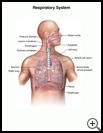
Bronchoscopy
What is a bronchoscopy?
A bronchoscopy is a procedure in which your healthcare provider examines the airways of your lungs with a thin, flexible, lighted tube called a bronchoscope. It may be performed in your hospital room or in a procedure room in the hospital. This procedure may be done because:
- You have an irritation, a growth, or scar tissue in your airways or lungs
- There may be an inherited deformity in your lungs
- There may be a foreign body, such as a peanut or coin, in your lungs
- You need your airways checked for signs of cancer
- You have a cough for more than 3 months or you are coughing up blood
- You need to have a sample of mucus taken to test for an infection
- You need to have a small sample of lung tissue (biopsy) taken for lab tests
How is a bronchoscopy done?
Before the bronchoscopy:
- Your healthcare provider will ask you to sign a consent form for a bronchoscopy. The consent form will state the reason you are having the test, what happens during the test, and what you may expect afterward.
- There is risk with every treatment or procedure. Talk to your healthcare provider for complete information about whether any of these risks apply to you:
- Anesthesia problems
- Infection
- Blood clots
- Bleeding
- Your provider may have you prepare for the bronchoscopy by not eating or drinking anything for several hours before the test.
- Tell your healthcare provider if you have any food, medicine, or other allergies such as latex.
- Tell your healthcare provider if you are taking any medicines, including nonprescription drugs, herbal remedies, or recreational or illegal drugs.
- You will have a needle inserted into a vein in your hand or arm. This will allow medicine to be given into your blood system and to give you fluids.
During the bronchoscopy:
- You may be given a sedative through your IV to help you to relax.
- You will be given medicines to prevent pain during your procedure. These may include:
- Local anesthesia, which will numb the back of your throat and help prevent gagging.
- General anesthesia, which relaxes your muscles and puts you into a deep sleep. It also keeps you from remembering the operation. While you are asleep, you will have a tube in your throat to help you breath and to make sure you are getting enough oxygen. The tube may be removed before you wake up after the surgery.
- Your blood oxygen level will be monitored by a sensor that is attached to your finger or earlobe.
- You may receive oxygen through a small tube placed under your nose or through a mask placed over your face.
- A cardiac (heart) monitor may be used to keep track of your heart’s rate and rhythm.
- Your healthcare provider will pass a bronchoscope into your mouth and throat, down the windpipe, and into your airways.
- If your provider finds cancer cells, growths, sores, or other unhealthy tissue, he or she may remove them or take a biopsy. If a foreign body is found, it is usually removed.
After the bronchoscopy:
- You may stay in the hospital for a few hours or several days to recover, depending on your condition and your test results.
- If you stay in the hospital after your test:
- You will be checked often by nursing staff.
- Your blood oxygen level may be monitored by a sensor that is attached to your finger or earlobe.
- You may feel some soreness in your neck and throat. The soreness may last a few days after the procedure.
- You may be hoarse or have a cough.
What can I do to help?
- You will need to tell your healthcare team if you have new or worsening:
- Cough
- Shortness of breath
- Wheezing
- Severe hoarseness
- Trouble swallowing
- Coughing up blood
- Chest pain
How can I take care of myself when I go home?
Call emergency medical services or 911 if you have new or worsening:
- Swelling of your lips, tongue or throat
- Trouble breathing
What does the result mean?
This test is only one part of a larger picture that includes your medical history and current health. Your provider will discuss with you any need for treatment based on what is seen with the bronchoscope. In some cases, your provider may be able to treat your condition during the bronchoscopy. If your provider is unable to treat your condition during the bronchoscopy, a treatment plan will be made for additional care.
If your results are not normal, ask your healthcare provider:
- If you need additional tests
- If or when you need to be tested again
- If you need treatment and what your treatment choices are
- If you need to make any lifestyle changes to keep your airway healthy
Last modified: 2016-02-08
Last reviewed: 2016-01-26

